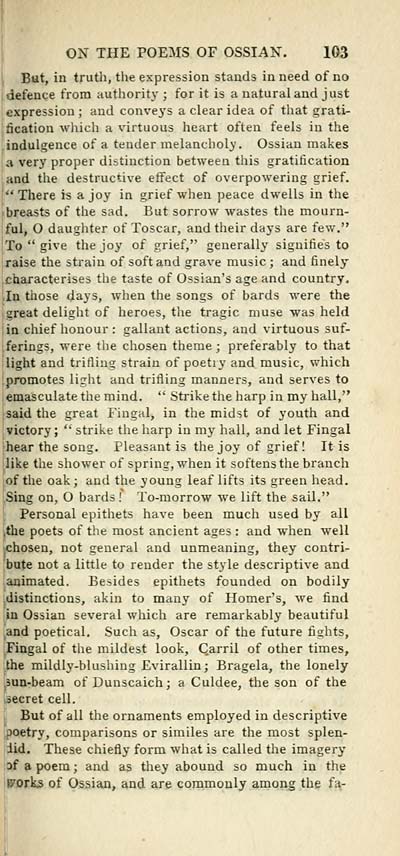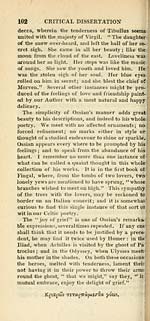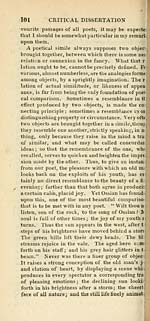Ossian Collection > Poems of Ossian
(151)
Download files
Complete book:
Individual page:
Thumbnail gallery: Grid view | List view

ON THE POEMS OF OSSIAN. 103
But, in truth, the expression stands in need of no
defence from authority ; for it is a natural and just
expression ; and conveys a clear idea of tliat grati-
fication which a virtuous heart often feels in the
indulgence of a tender melancholy. Ossian makes
a very proper distinction between this gratification
and the destructive effect of overpowering grief.
" There is a joy in grief when peace dwells in the
breasts of the sad. But sorrow wastes the mourn-
ful, O daughter of Toscar, and their days are few."
To " give the joy of grief," generally signifies to
raise the strain of soft and grave music ; and finely
characterises the taste of Ossian's age and country.
In those days, when the songs of bards were the
great delight of heroes, the tragic muse was held
in chief honour : gallant actions, and virtuous suf-
ferings, were the chosen theme ; preferably to that
light and trifling strain of poetiy and music, which
promotes light and trifling manners, and serves to
emasculate the mind. " Strike the harp in my hall,"
said the great Fiugal, in the midst of youth and
victory; " strike the harp in my hall, and let Fingal
hear the song. Pleasant is the joy of grief ! It is
like the shower of spring, when it softens the branch
of the oak ; and the young leaf lifts its green head.
Sing on, O bards I To-morrow we lift the sail."
Personal epithets have been much used by all
,the poets of the most ancient ages : and when well
chosen, not general and unmeaning, they contri-
bute not a little to render the style descriptive and
animated. Besides epithets founded on bodily
distinctions, akin to many of Homer's, we find
in Ossian several which are remarkably beautiful
and poetical. Such as, Oscar of the future fights,
Fingal of the mildest look, Qarril of other times,
the mildly-blushing Evirallin; Bragela, the lonely
.3un-beam of Dunscaich; a Culdee, the son of the
secret cell.
But of all the ornaments employed in descriptive
poetry, comparisons or similes are the most splen-
lid. These chiefly form what is called the imagery
Df a poem ; and as they abound so much in the
B'Drks of Ossian, and are commonly among the fa-
But, in truth, the expression stands in need of no
defence from authority ; for it is a natural and just
expression ; and conveys a clear idea of tliat grati-
fication which a virtuous heart often feels in the
indulgence of a tender melancholy. Ossian makes
a very proper distinction between this gratification
and the destructive effect of overpowering grief.
" There is a joy in grief when peace dwells in the
breasts of the sad. But sorrow wastes the mourn-
ful, O daughter of Toscar, and their days are few."
To " give the joy of grief," generally signifies to
raise the strain of soft and grave music ; and finely
characterises the taste of Ossian's age and country.
In those days, when the songs of bards were the
great delight of heroes, the tragic muse was held
in chief honour : gallant actions, and virtuous suf-
ferings, were the chosen theme ; preferably to that
light and trifling strain of poetiy and music, which
promotes light and trifling manners, and serves to
emasculate the mind. " Strike the harp in my hall,"
said the great Fiugal, in the midst of youth and
victory; " strike the harp in my hall, and let Fingal
hear the song. Pleasant is the joy of grief ! It is
like the shower of spring, when it softens the branch
of the oak ; and the young leaf lifts its green head.
Sing on, O bards I To-morrow we lift the sail."
Personal epithets have been much used by all
,the poets of the most ancient ages : and when well
chosen, not general and unmeaning, they contri-
bute not a little to render the style descriptive and
animated. Besides epithets founded on bodily
distinctions, akin to many of Homer's, we find
in Ossian several which are remarkably beautiful
and poetical. Such as, Oscar of the future fights,
Fingal of the mildest look, Qarril of other times,
the mildly-blushing Evirallin; Bragela, the lonely
.3un-beam of Dunscaich; a Culdee, the son of the
secret cell.
But of all the ornaments employed in descriptive
poetry, comparisons or similes are the most splen-
lid. These chiefly form what is called the imagery
Df a poem ; and as they abound so much in the
B'Drks of Ossian, and are commonly among the fa-
Set display mode to: Large image | Transcription
Images and transcriptions on this page, including medium image downloads, may be used under the Creative Commons Attribution 4.0 International Licence unless otherwise stated. ![]()
| Early Gaelic Book Collections > Ossian Collection > Poems of Ossian > (151) |
|---|
| Permanent URL | https://digital.nls.uk/77990614 |
|---|
| Description | Selected books from the Ossian Collection of 327 volumes, originally assembled by J. Norman Methven of Perth. Different editions and translations of James MacPherson's epic poem 'Ossian', some with a map of the 'Kingdom of Connor'. Also secondary material relating to Ossianic poetry and the Ossian controversy. |
|---|
| Description | Selected items from five 'Special and Named Printed Collections'. Includes books in Gaelic and other Celtic languages, works about the Gaels, their languages, literature, culture and history. |
|---|

